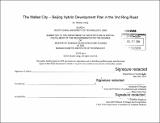| dc.contributor.advisor | Alexander D'Hooghe. | en_US |
| dc.contributor.author | Liang, Shaoyi | en_US |
| dc.contributor.other | Massachusetts Institute of Technology. Department of Architecture. | en_US |
| dc.coverage.spatial | a-cc--- | en_US |
| dc.date.accessioned | 2014-11-04T21:34:33Z | |
| dc.date.available | 2014-11-04T21:34:33Z | |
| dc.date.copyright | 2014 | en_US |
| dc.date.issued | 2014 | en_US |
| dc.identifier.uri | http://hdl.handle.net/1721.1/91408 | |
| dc.description | Thesis: S.M., Massachusetts Institute of Technology, Department of Architecture, 2014. | en_US |
| dc.description | Cataloged from PDF version of thesis. | en_US |
| dc.description | Includes bibliographical references (page 41). | en_US |
| dc.description.abstract | The circular ring roads are one of the key elements that define the spatial organization of Beijing today. However, as the city continues to expand, the ring roads located in the inner city, combined with the gridded street-networks, usually creates more problems than solutions. The second ring road, constructed in the early 1980s-at the era of China's Economic Reform, proves to be a major example of such an issue. Despite its intention to create rapid transportation paths around the periphery of the city, as the city expands, this ring-structure serves as a new center for the city; it is notorious for its traffic jams, pollution, and drastically degenerated urban environment-a "wall" that cuts off two sides of the city and its associated urbanity. The thesis explores the potential of new intervention on the site of the second ring road, adopting and addressing the city's transportation infrastructure as a vehicle to providing much-needed public space, new programs, and other civic amenities for the city. The proposition is that in the design of the city, architecture, open space, and infrastructure should be combined as one intertwined discipline. The strategic deployment of urban and architectural forms, applied with contextual considerations, are devised to re-introduce the "urban characteristics" back to the city. | en_US |
| dc.description.statementofresponsibility | by Shaoyi Liang. | en_US |
| dc.format.extent | 98, 2 unnumbered pages | en_US |
| dc.language.iso | eng | en_US |
| dc.publisher | Massachusetts Institute of Technology | en_US |
| dc.rights | M.I.T. theses are protected by copyright. They may be viewed from this source for any purpose, but reproduction or distribution in any format is prohibited without written permission. See provided URL for inquiries about permission. | en_US |
| dc.rights.uri | http://dspace.mit.edu/handle/1721.1/7582 | en_US |
| dc.subject | Architecture. | en_US |
| dc.title | The walled city : Beijing hybrid development plan in the 2nd ring road | en_US |
| dc.title.alternative | Beijing hybrid development plan in the 2nd ring road | en_US |
| dc.type | Thesis | en_US |
| dc.description.degree | S.M. | en_US |
| dc.contributor.department | Massachusetts Institute of Technology. Department of Architecture | |
| dc.identifier.oclc | 893562497 | en_US |
